Francisco Pradilla (1848–1921): Más que un pintor de historia (Francisco Pradilla [1848–1921]: More than a History Painter)
Reviewed by Andrew GingerAndrew Ginger
Professor of Comparative Studies and Vice Provost for International Engagement
Northeastern University
Email the author: a.ginger[at]northeastern.edu
Citation: Andrew Ginger, exhibition review of Francisco Pradilla (1848–1921): Más que un pintor de historia (Francisco Pradilla [1848–1921]: More than a History Painter), Nineteenth-Century Art Worldwide 23, no. 1 (Spring 2024), https://doi.org/10.29411/ncaw.2024.23.1.17.
This work is licensed under a Creative Commons Attribution-NonCommercial 4.0 International License  unless otherwise noted.
unless otherwise noted.
Your browser will either open the file, download it to a folder, or display a dialog with options.
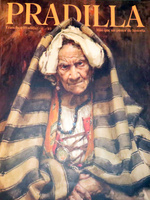
Francisco Pradilla (1848–1921): Más que un pintor de historia (Francisco Pradilla [1848–1921]: More than a History Painter)
Museo de Historia de Madrid, Madrid
December 14, 2022–May 14, 2023
Catalogue:
Soledad Cánovas del Castillo, ed.,
Francisco Pradilla (1848–1921): Más que un pintor de historia (Francisco Pradilla [1848–1921]: More than a History Painter).
Madrid: Museo de Historia de Madrid, 2022.
275 pp.; 165 color illus.; chronology; list of visitors and clients at the painter’s studio in Rome; list of honors and distinctions; list of works in Spain and abroad; bibliography; list of exhibitions.
€30 (softcover)
ISBN: 978–84–7812–842–6
In the catalogue to this recent exhibition, its curator Soledad Cánovas del Castillo recounts a striking anecdote. When she began working on the project, someone remarked that everything that could be said about Francisco Pradilla (1848–1921) had been said (15). In a way, the remark is unsurprising. To the extent that Pradilla is at all well-known inside Spain, it is for a tiny number of large-scale history paintings, especially the haunting, seventeen-square-meter image of Doña Juana la Loca (Juana the Mad) (1877; Museo del Prado, Madrid), the widowed queen of Spain, standing by her husband’s coffin in the open air during its long procession across the country. In the English-speaking world, Pradilla is hardly even a name except to those who happen to have taken an interest in nineteenth-century Spanish art, or perhaps those who have strolled by the nineteenth-century history paintings in the Prado. In a century of long-neglected art—Goya (1746–1828) aside—Pradilla has tended to be situated in a second rank behind relatively more famous (or less unknown) painters such as Mariano Fortuny (1838–74), Eduardo Rosales (1836–73), Eugenio Lucas Velázquez (1817–70), or Joaquín Sorolla (1863–1923). Even so, he has been the subject of several studies in the last decades, including monographs and essays by Wilfredo Rincón García. Perhaps then, it might indeed seem that what could be said about Pradilla must already have been said.
A number of exhibitions have been dedicated to the painter, with several in the last five years: in 2018, in Pozuelo de Alarcón (Madrid)—also curated by Cánovas del Castillo and Sonia Pradilla Sánchez—and in 2021, in Zaragoza, with 187 works curated by Rincón García. In 2022, the Prado set aside a single room for eight paintings by Pradilla, focused on his work as a distinguished history painter. The anniversary of Pradilla’s death has acted as a catalyst for the most recent displays, coinciding with the terrible pandemic which delayed the exhibition in Madrid. The subtitle of the exhibition and catalogue under review here—More than a History Painter—underlines how Pradilla’s work bursts out of its narrower and slighter reputation, to which the Prado’s modest display—for all its merits—remained somewhat confined. Both this and the 2021 Zaragoza show lay claim to exhibiting large numbers of works that have not been seen in public, at least since their own time: 45 percent of those in Zaragoza, 20 percent of those in Madrid. In fact, the Pradilla we see here, reconstructed through years of research and publication, is only occasionally a history painter, though he remained active in the genre as late as 1907, when he produced his disturbing follow-up vision of the deposed Juana the Mad confined in her insanity. He is a painter of landscapes, of folk scenes, of portraits, of allegorical and symbolic images; he is an artist of watercolors and of illustrations. Speaking at the Zaragoza exhibition, Rincón García was moved to say that, even in his history paintings, Pradilla was a frustrated landscapist.[1] The presence of so many post-1900 works firmly reminds us that Pradilla was mainly an early twentieth- and very late nineteenth-century painter, not a creature of the high point of grandes machines.
Pradilla’s work, as shown here, kicks against easy categorizations and chronological phases of nineteenth- and early twentieth-century art and artists. It has a restlessness to it, a wrestling with legacies and trends. Pradilla’s little seaside painting, Porto d’Anzio (Port of Anzio; fig. 1), with its elegant beach roamers, its rolling waves, and vast, dull sea and sky, is in dialogue with his younger mentee Joaquin Sorolla’s development of the luminous seaside scenes that were to characterize his career. Yet soon afterward Pradilla revisited the venerable genre of history painting with the nearly five square meters of La reina Juana la Loca, recluida en Tordesillas con su hija, la infanta Catalina (Queen Juana the Mad, Confined in Tordesillas with Her Daughter, the Infanta Catalina, 1907; Museo del Prado, Madrid), represented in the catalogue by a sketch and two versions of 1906 and 1907. The dynamic impasto blur of Deshoje del maíz, Terracina (Corn Husking, Terracina; fig. 2) returns to a subject Pradilla painted sixteen years earlier and echoes the explosive smoke of his El cráter de Vesubio (Crater of Vesuvius, 1887; Serrano Alberca collection, Madrid). And, in 1909, as his famous compatriot Pablo Picasso (1881–1973) was embarking on analytical Cubism, Pradilla produced an extraordinary figurative portrait of an old woman—El día de Corpus Christi en Italia (Day of Corpus Christi in Italy; fig. 3)—which graces the front cover of the catalogue. It is hard to imagine that this rugged, characterful visage, pressing its gaze determinedly, enigmatically upon the viewer, could have been conjured out of watercolor on paper. Like other important exhibitions of painters of this period—notably, the UK National Gallery’s Sorolla: Spanish Master of Light (2019)—Pradilla: More than a History Painter implicitly challenges the predominance of Picasso’s early innovations in the historical trajectory of Spanish art. Perhaps, one day, we will see a major international exhibition that juxtaposes early Picasso with the full range of his contemporary compatriots, including Pradilla.

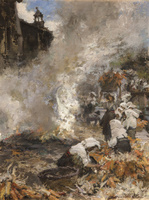
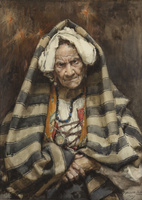
The catalogue expands on Pradilla’s complexity and heterogeneity. Alongside high-quality reproductions of eighty catalogue entries organized into five sections with the titles “Historical Evocations,” “Allegories and Medieval Scenes,” “En Plein Air,” “Moeurs and Modernity,” “Portraits,” and “Watercolors and Drawings,”[2] the volume includes not just contextual essays and commentary, but a range of other materials, supported by even more images. There is a long autobiographical letter of May 1892 to the President of the Royal Academy of Berlin (with an English translation), surviving letters to and from friends and acquaintances across Spain and Europe (most were lost in the Spanish Civil War), the admiring dedicatory essay on Pradilla’s art that opens Luis de Ocharan de Mazas’s 1916 novel Marichu, information on the restoration of El suspiro del moro (The Moor’s Sigh, 1879–92; Antonio Cánovas del Castillo-Altair collection, Madrid), personal objects, lists of visitors to Pradilla’s studio in Rome and of the awards he received across Europe, and a detailed chronology that highlights Pradilla’s presence in the international art markets of late nineteenth- and early twentieth-century Europe. Correspondence from 1919 highlights efforts to involve Pradilla in a Parisian exhibition of contemporary Spanish art, providing a fascinating vista on what was deemed modern as the Great War ended: influential French art dealers insisted that, without Pradilla, such an exhibition would be a travesty (62).
The restlessness of the exhibition’s paintings is amplified by the accompanying written material. Occasionally, Pradilla verges on the cantankerous. Writing in November 1912 to Archer Milton Huntington (1870–1955), founder of the Hispanic Society and the great US patron to Spanish artists, Pradilla suddenly reverses the purchase of a painting: he has decided that the piece does not sufficiently reflect his own artistic quality and importance. Instead, he offers forty reproductions of other works (86). Such anxious outbursts and abrupt interventions speak to constant tensions between his high artistic aspirations, his financial needs, his contingent circumstances, and his perceived relationship with his own country. The variety of his paintings is in part due to a financial situation that he found exasperating. In an extraordinary letter of November 1894, Pradilla responded to being named an associate member of the Institut de France by offering his resignation should he continue to be limited by his life circumstances to painting small works made to buyers’ tastes (71).
Through the correspondence, we see his frustrated interjections intensify once he loses the savings he invested in the soon bankrupt House of Villosadas. Spanish courts gave Pradilla little succor for what he portrays as a scam. This decisive episode exacerbated a love-hate relationship with his native land that is apparent in his (and some other Spanish artists’) history paintings. The memorable national subjects that he selects show those victimized by the victors of Spanish history: the deposed Juana the Mad, and the vanquished Islamic King of Granada. Pradilla would have included the expelled Jews had he been able to complete that work (35). In the exhibition and catalogue, such themes are represented by Pradilla’s own reduced versions of his 1877 and 1907 visions of Juana the Mad, and of his La rendición de Granada (Surrender of Granada, 1882; Palacio del Senado, Madrid) produced for Spain’s Senate, alongside the nearly six square meters of The Moor’s Sigh, intended for the London art dealer Henry Wallis (1805–90). While Pradilla fervently describes himself as a truly Spanish artist and is supplicant and grateful to royalty, he speaks in the vein of an angry victim, too, his love for his country insufficiently requited. As early as 1883, he complained to the Senate that, by not lending The Surrender of Granada for an international competition in Munich, it would prevent him from jousting for the nation in the lists of European art (104–5). In July 1898, in the face of impending defeat by the United States and the loss of imperial territory, Pradilla not only claimed Spain was riddled with wickedness beyond redemption but saw in his ill-treatment by the courts a prophesy of this military collapse (107).
At the same time, Pradilla deliberately pursued varied styles and genres, making it difficult to distinguish between changes he felt obliged to adopt and others that he willed. In asserting the importance of his work to Huntington, Pradilla speaks of the “diverse aspects of my art” (86).[3] While Pradilla remained fixated on the importance of large-scale oils to the very end, the catalogue observes that he called the watercolor The Day of Corpus Christi in Italy “my favorite, and vanity aside, it has no peer to this day in the world in its genre” (191).[4] Through the years and these variations, Pradilla expresses a consistent aspiration, even if he did not stick to a single style. In this, he is like several of Spain’s finest artists since the late eighteenth century—Goya and Picasso certainly, but also Lucas Velázquez, and perhaps Genaro Pérez Villaamil (1807–54), too—for whom the creation of a signature “style” was a far less pressing concern than it was for many of their French counterparts—or indeed for those theorists, historians, and aestheticians who privilege French reference points. In a letter to the Infanta Paz de Borbón y Borbón (1862–1946), written in August 1893, Pradilla sets out his own consistent aspiration as a painter: to “cultivate [the] pure art, free of obstacles and concessions,” which is “the work of the intellect and the spirit” (66).[5] Eighteen years later, in correspondence with the notable post-Wagnerian composer Felip Pedrell (1841–1922), he still uses the same phrase—“[the] pure art”—and complains of how “societies soak up the kind of art they need or delight in, and spit out the rest.”[6] This purist aspiration, beyond taste and preference, impels him to row against prevailing intellectual tides, just as he railed against the direction of contemporary Spanish history. “When we were born to Art,” he writes Pedrell, “romanticism was dying, naturalism was being born and was fatally to join with positivism and worse, as we are now seeing” (93).[7]
We may spy this critically recalcitrant outlook in Pradilla’s refusal to discard genres and styles simply because they are not of a given moment. In his 1912 painting Mal de amores, siglo XV (Love Sickness, 15th Century; fig. 4), he offers us an archaizing medievalism combined with sickly innuendo, almost as if the pre-Raphaelites had made a comeback. We may detect his struggle for pure art in the relentless probing of different genres, different subjects, different styles, as if to test their various aesthetic possibilities. The Moor’s Sigh twists history painting to an unsettled perspective, a column of exiles turning towards and away from us around a vast horse’s rump at the center of the image, and leading us on to a distant Boabdil, the supposed protagonist, his back to us, his figure merging with the incoming clouds. In Así transcurre la vida (So Life Passes; fig. 5), a symbolist-like image of a classical woman gazing on a waterfall breaks into sensuous, thick, rough strokes of light and shade in multiple directions. The Romantic topos of crepuscular light becomes just three scrubby, two-dimensional bands of intense red, black, and blue-grey in Atardecer en Roma (Sunset in Rome; fig. 6). A portrait in traditional costume, The Day of Corpus Christi in Rome, brings together a dulled psychedelic blur of a backdrop, with the stark abstract geometries of a large headscarf, and—one of Pradilla’s favorite, repeated motifs—the woman’s arresting, insistent, but elusive stare at the viewer. If many of the paintings seem about to dissipate in mist, smoke, haze, and cloud, as if on the edge of their own eclipse—from Juana the Mad fusing with a smokey campfire in 1877 to the nebulous sky mirrored and rippled in glistening waters in Niebla de primavera (Italia) (Spring Fog [Italy]; fig. 7)—Pradilla is capable also of the overwhelming brightness, the over-sharp photographic lines, the hallucinatory, saturated colors, and willful joy of Para mi boda. . .! Encajera de bolillos (For My Wedding. . .! Bobbin-Lace Maker; fig. 8). Pradilla’s work—dark or bright—seems often to reach for a limit point, an edge—a breakthrough, in the perilous as well as the positive sense.
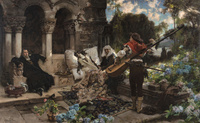
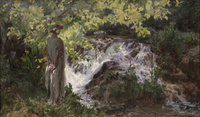
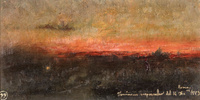
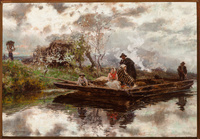
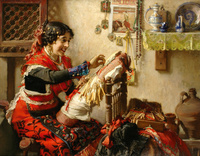
In the letters, we find Pradilla aiming to be a sort of artist-producer, a sweet spot where purity and revenue-generation converge, where the productive individual takes back commercial and artistic property from the forces of speculative finance. Like his other aspirations, this frustrated longing turns at times to irritation, to drastic decisions, and to desperate efforts to reassert control over his life circumstances. In July 1887, he writes from Rome to the former London art dealer, Ernest Gambart (1814–1902), “I desire only to continually improve my prices, desirous of producing less to do it better . . . I am firmly decided to make good paintings that I will get a good price for” (74).[8] Unable to achieve this, he explains to the Infanta Paz de Borbón y Borbón in August 1893 that so long as he has to produce commercial paintings he will steer far away from exhibitions. He thus takes himself completely out of the public eye and at the same time seeks anxiously to stop galleries and dealers displaying works without his say-so. He seems to want absolutely to control the selection of his art that the public gets to see, on the grounds that his reputation is what puts food on the table for his family and that he must prevent “speculation from gathering the fruit that by right belong to the artist who is the producer” (66).[9] He clearly feels the same way about unauthorized reproductions of his images. He declares himself now to be no less than the victim of “financial plundering” (66).[10] From a strictly historical perspective, this facet of Pradilla’s career makes it even more difficult to know what to make of the rediscovered variety of his paintings as shown in this and other recent exhibitions. Which of his works did Pradilla view as “pure” and which did he not among those that were absent from public exhibitions in his lifetime?
Pradilla’s fraught quest for purity—and for earnings—played out not just on a Spanish, but on a truly international stage. The commentary, chronology, and letters (arranged by correspondent) forcefully demonstrate how internationally connected Pradilla was and the extent to which he was honored and sought-after far beyond his native land, or even Italy. There—like many other Spanish artists—he held a scholarship at the Spanish School in Rome, he befriended the major painter Domenico Morelli (1823–1901), and—as an appendix to the catalogue shows—he received a large number of visitors from across Europe. Pradilla corresponded with and was decorated by academies in Paris and Berlin; German dealers hunted down every piece they could to sell them; French dealers praised his paintings; and as a matter of fact, his work was exhibited and sold extensively in Britain during his lifetime. We find him writing to a prominent German dramatist (Ludwig Fulda [1862–1939]) just as we see him corresponding with the towering Spanish politician Antonio Maura (1853–1925), and—a new discovery—the brilliant late nineteenth- and early twentieth-century Spanish historical and contemporary novelist Benito Pérez Galdós (1843–1920), Pradilla’s almost exact contemporary.
More than a History Painter adds substantially to the growing but still emerging awareness of how internationally visible and valued Spanish art actually was from 1860 onwards, and how intertwined Spanish, European, and transatlantic cultural networks were. US collectors and artists were entranced by artists from Fortuny to Sorolla.[11] Specifically, the catalogue of More than a History Painter helps foreground the strong connections between Madrid and places other than Paris, the supposed capital of the nineteenth century. The close links and shared taste between Pradilla, painting in Spain and Italy, and the public and connoisseurs of Berlin is a striking example of networks bypassing Paris—to such an extent that one of Pradilla’s late-life frets was that after World War I the victorious French public perceived him as a Germanophile and that they were boycotting his work (101). For Pradilla himself, such widespread international recognition was a source at once of immense pride—confirming his artistic importance—and of frustration, insofar as he felt that his unprecedented success was too often forgotten or overlooked. He would presumably be horrified but unsurprised by the present state of affairs, in which hardly anyone outside—and not that many people inside—Spain have ever heard of him. Bitterly, but once more assertively against the tide of the times, he wrote Huntington in 1912 that “whatever the degree to which people need to bring down my modest ‘oeuvre’, it is a ‘fact’ and it is ‘history’ that the first time Spanish painting obtained great medals of honor in Madrid, Paris, Munich, Vienna, and Berlin, it obtained them solely with works by my hand” (86).[12]
The major, ongoing effort in recent studies and exhibitions of nineteenth-century Spanish art has been to show that it mattered and matters. Matter here means two things, which while overlapping, are quite distinct, and have become too often conflated. This art mattered in the sense that there was a lot of varied, lively activity, that this activity played a prominent role in Spanish society, and that—as we more and more realize—it was visible, commented on, and connected to networks across Europe and the Atlantic. That is to say, if you are going to look at the cultural history of Europe and the Atlantic, then nineteenth-century Spanish art has to be part of the rich, varied picture. But some of it matters (present tense) in another, very important sense: it matters because it opens up significant, compelling perspectives on what art might be that we do not find in other art, because it challenges our assumptions and offers us alternate aesthetic and intellectual possibilities. It is obviously in this sense that Goya matters, that Picasso (for better and worse) matters. It is in this sense that Romantic, realist, and impressionist French painting once staked its hegemonic claim over nineteenth-century Europe, and that, more recently, other painters, like the Pre-Raphaelites have been vigorously reclaimed and re-asserted.[13]
Bold efforts have been undertaken to show that Spanish nineteenth-century art—and a wider range of Spanish early twentieth-century art—mattered. The Prado opened its nineteenth-century galleries in 2007 in the main Villanueva building, integrating works that were previously set apart in a different edifice—the Casón del Buen Retiro—into the narrative of art across the centuries. This move likewise put nineteenth-century Spanish artworks back next to the paintings of Francisco Goya, from which they had become physically separated.[14] Visitors are now far more likely to wander through the nineteenth-century galleries. The various rooms proffer varied facets of the period: the Ingres-like portraitists, the history painters, the realist landscapists and so forth, as well as showcasing certain individuals such as Fortuny. The effort to foreground and value historically significant techniques and genres—like fashionable portraiture—has reduced the presence of adventurous art and artists (notably Leonardo Alenza [1807–45] and Lucas Velázquez) that had been much more visible in the Casón. With a similar cumulative effect, there have been more and more exhibitions, large and small, in the Prado and elsewhere on diverse Spanish artists and aspects of art of this period. All of this effectively brings home the point that there were things that historically mattered.
The provocative variety of an exhibition like Pradilla: More than a History Painter—running against the grain of many assumptions—leaves us to ponder how Spanish art of this period matters and to what extent. It makes us reconsider what and how much might be at stake artistically, ideologically, and intellectually. In visiting the exhibition and writing this review, I have lingered over that question. I began by noting that, when Soledad Cánovas del Castillo began working on the project, someone claimed that everything that could be said about Francisco Pradilla had been said. I find myself thinking that, with Pradilla—as with so much Spanish art of his time and before—there remains so very much to think about, so very much that has not yet been said about what matters. We have really only just begun.
Notes
Translations provided by the author of this review.
[1] “Francisco Pradilla, entre la pintura de historia y el paisaje visto con nuevos ojos,” Heraldo, August 10, 2021, accessed December 18, 2023, https://www.heraldo.es/.
[2] “Evocaciones históricas”; “Alegorías y escenas medievales”; “Al aire libre”; “Costumbrismo y modernidad”; “Retratos”; “Acuarelas y dibujos.”
[3] “Los diversos aspectos de mi arte.”
[4] “Mi favorita, y vanidad aparte, no tiene par hasta el día de hoy en el mundo, en su género.”
[5] “Cultivar el arte puro, libre de trabas y concesiones; la obra de la inteligencia y del espíritu.”
[6] “Las sociedades absorben el tipo de arte que necesitan o gustan, y escupen las demás.”
[7] “Cuando nacimos al Arte, moría el romanticismo, nacía el naturalismo que fatalmente había de empalmar con el positivismo y peor, como estamos viendo.”
[8] “No deseo más que mejorar siempre mis precios, deseoso de producir menos para hacerlo major . . . estoy firmemente decidido a hacer buena pintura que haré pagar bien.”
[9] “La especulación recoja el fruto que de derecho pertenece al artista que es el productor.”
[10] “Expolio financiero.”
[11] See, for example: M. Elizabeth Boone, Vistas de España: American Views of Art and Life in Spain, 1860–1914 (New Haven: Yale University Press, 2007).
[12] “Sea cualquiera el grado a que se requiera rebajar mi modesta ‘obra’, es un ‘hecho’ y es ‘historia’ que la primera vez que la pintura española obtuvo grandes premios de honor en Madrid, París, Múnich, Viena y Berlín, las obtuvo con obras de mi mano.”
[13] Notably in Elizabeth Prettejohn, The Art of the Pre-Raphaelites (London: Tate, 2000); David Peters Corbett, The World in Paint: Modern Art and Visuality in England, 1848–1914 (Manchester: Manchester University Press, 2004).
[14] The inaugural exhibition for the new nineteenth-century section, and the corresponding catalogue, were the subject of a thoughtful review in this journal: Isabel Valverde, exhibition review of El siglo XIX en el Prado, Nineteenth-Century Art Worldwide 7, no. 2 (Autumn 2008), accessed December 18, 2023, http://www.19thc-artworldwide.org/autumn08/79-el-siglo-xix-en-el-prado.